June 27, 2008
Air Date: June 27, 2008
FULL SHOW
SEGMENTS
20 Years of Urgency
View the page for this story
NASA scientist James Hansen marked the 20th anniversary of his testimony before Congress in which he declared human-caused global warming a threat to the planet by restating his concerns before Congress. (01:30)
Tipping Point?
View the page for this story
NASA scientist James Hansen and other leading scientists say 350 parts per million of carbon dioxide in the air should be our target goal to reduce greenhouse gas emissions. Professor Richard Alley of Pennsylvania State University explains to host Bruce Gellerman where that number comes from and how we can get there. (03:10)
Not-So-Perma Permafrost
View the page for this story
New research shows melting sea ice caused by global warming may be causing permafrost to melt more quickly. Dr. Andrew Slater from the National Snow and Ice Data Center explains to host Bruce Gellerman that the warming could be having unintended consequences – both positive and negative - for the tundra ecoysystem. (05:30)
Agent Orange Researcher Passes
View the page for this story
When Arthur Galston discovered a chemical compound that could make soybeans flower early, he didn’t suspect that the chemical would be used by the U.S. Army to create Agent Orange, the toxic defoliant employed in the Vietnam War. Galston lobbied then Presidents Johnson and Nixon to halt the use of the dangerous substance, and spoke out on bioethics and the risks of scientific research. Living on Earth honors Arthur Galston who died recently at age 88. (01:40)
Small Technology, Big Questions
/ Jeff YoungView the page for this story
Living on Earth_s new series on nanotechnology explores the big questions about some tiny materials. Manipulating matter at the molecular level opens amazing opportunities for new medicines and materials. But these new materials also create potential risks to health and the environment. Jeff Young looks at nanosilver products already on store shelves. (08:30)
Green on the Go
View the page for this story
What to do on your summer vacation? Plenty Magazine assistant editor Tobin Hack has some green tips. She tells host Bruce Gellerman that with soaring gas prices, travelers might consider staying close to home, packing light, and taking public transportation this summer. (05:20)
Bumper to Bumper Bikes
View the page for this story
As gas prices rise, bike commuting is also on the up and up. Living on Earth went to a bike store in L.A. to check in on the booming business, and also flagged down some bike commuters in Boston during morning rush hour to ask about their rubber-to-the-road habits. (04:30)
Warm Water and Small Sea Creatures
/ Andrew RyanView the page for this story
Tiny plankton play an important role in the ocean ecosystem. Scientists believe they may be able to witness some of the effects of climate change by tracking the size and number of these and other organisms and fish living in the water. Radio Deutsche-Welle's Andrew Ryan took a trip to the islands of Helgoland with researchers to see what they could see at the bottom of the North Sea. (06:30)
Sustaining Life
View the page for this story
Preventing species extinction isn't just good for the planet, it's also good for our health. Aaron Bernstein and Eric Chivian, co-editors of "Sustaining Life: How Human Health Depends on Biodiversity," talk with Living on Earth host Bruce Gellerman about why we should care about horseshoe crabs and microbes. (10:00)
Show Credits and Funders
Show Transcript
Host: Bruce Gellerman
Guests: Richard Alley, Andrew Slater, Tobin Hack, Eric Chivian, Aaron Bernstein, Candace Rancier
Reporters: Jeff Young, Ingrid Lobet, Ashley Ahearn, Andrew Ryan
[THEME]
GELLERMAN: From Public Radio International - this is Living on Earth.
[THEME]
GELLERMAN: I’m Bruce Gellerman. Small is beautiful - nano-tech products are the next big thing…
MAYNARD: Manufacturers are like kids in a toy store at the moment. They've got new tech nanosilver - they're putting it everywhere, they are so excited about it, but nobody’s really thinking about the long-term consequences of that.
GELLERMAN: How does nanotech measure up safety-wise – nobody knows, when things get very small, they get very weird. Coming up – Let’s Get Small - the first in a series of stories about nanotechnology. Also preserving biodiversity as if your life depended on it.
BERNSTEIN: When I give a child a vaccine – which is probably the most important thing I do as a doctor to prevent disease –how do I know that that vaccine is safe, and the answer is – because of the horseshoe crab.
GELLERMAN: Crabs and frogs and microbes – oh my! Biodiversity. These stories, this week on Living on Earth. Stick around!
[NPR NEWSCAST: Boards Of Canada “Zoetrope” from “In A Beautiful Place Out In The Country” (Warp Records 2000)]
20 Years of Urgency
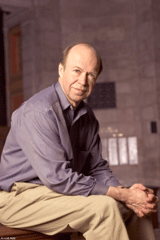
James Hansen (Courtesy of NASA)
GELLERMAN: From the Jennifer and Ted Stanley Studios in Somerville, Massachusetts – it’s Living on Earth. I’m Bruce Gellerman, in for Steve Curwood.
According to a new report by the Federal Energy Information Administration, the world’s demand for energy will increase by 50 percent over the next two decades. Most will come from coal, gas and oil. Ironically, the study was released precisely 20 years to the day that NASA scientist James Hansen testified before congress that global warming - caused by the burning of fossil fuels - was a threat to the planet.
June 23, 1988 was a sweltering day in Washington - the hottest on record - and Dr. Hansen certainly took some heat for his public position. He was lambasted by climate change deniers and nearly lost his government job.
This past week, to commemorate that anniversary, Dr. Hansen was invited to testify before a House Special Committee on Global Warming and at a National Press Club luncheon in his honor he was toasted by former Colorado Senator Tim Wirth.
WIRTH: Jim Hansen is a hero of science, a hero of our planet, and our honored guest today. So please join me in welcoming Dr. James Hansen.
[APPLAUSE]
GELLERMAN: But in the 20 years since Hansen first warned lawmakers of human caused climate change, Congress hasn’t passed any law mandating cuts in greenhouse gas emissions. Dr. James Hansen:

James Hansen (Courtesy of NASA)
GELLERMAN: Since Hansen’s 1988 testimony 21 new coal-fired power plants have been built in the US, and our emissions of carbon dioxide have climbed 18 percent. Hansen blames energy company executives for inaction:
HANSEN: It’s largely because of fossil fuels special interests who have supported what I would call misinformation. In my opinion I say if they don’t change their tactics that they’re guilty of crimes against humanity and nature.
GELLERMAN: Time is not on our side warns James Hansen. Back in 1988, when he first testified, the concentration of carbon dioxide in the atmosphere was 350 parts per million. He calls that, “a tipping point” for the planet.
HANSEN: I can say with a very high degree of confidence - I would say that more than 99.9 percent certain - that the safe level of CO2 is no more than 350 ppm - the long-term safe level. And we have already passed that level.
Related link:
James Hansen’s website
Tipping Point?
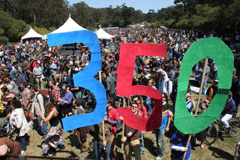
Earth Day at Golden Gate Park. (Courtesy of 350.org)
GELLERMAN: Today, the amount of CO2 in the atmosphere is 385 parts per million and organizers of a new environmental group called “350 dot org” say that’s got to come down. 350 parts per million maybe the new atmospheric gold standard for some, but Richard Alley, professor of Geosciences at Penn State University says it’s not gospel:
ALLEY: It is certainly not a sacred or a magic number. People have tried asking experts, “How high before you get scared?” “How high before YOU get scared?” And the experts came back and said, “Scared about what?”
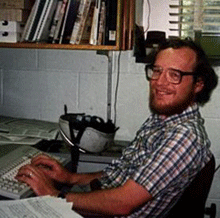
Dr. Richard Alley is the Evan Pugh professor of geosciences at Pennsylvania State University. (Courtesy of Pennsylvania State University)
GELLERMAN: Well right now we’ve got 385 parts per million. We’re looking at a ten percent reduction if they want to go back to 350. So how do we reduce our parts per million from 385 to 350?
ALLEY: There’s this huge recipe of possibilities that you can do. You can take the CO2 out of the air and put it back in the ground. You can take it from the power plant or take it from the air and people are trying to figure out how to do that. You get more economy out of the fossil fuel that you use. You replace the fossil fuel with something else that doesn’t raise CO2.

Earth Day at Golden Gate Park. (Courtesy of 350.org)
ALLEY: We can’t solve the problem by ourselves but I don’t think that the world can solve the problem without us.
GELLERMAN: Well Professor Richard Alley, thank you very much.
ALLEY: A real pleasure, thank you.
GELLERMAN: Richard Alley is a professor of Geosciences at Penn State University.
Related link:
Dr. Richard Alley’s Homepage
Not-So-Perma Permafrost
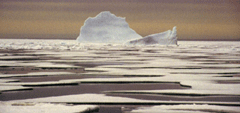
Well, if you lived in the Arctic you’d already notice the effects of climate change. The Arctic sea ice is melting at a rapid and accelerating pace and it’s having a dramatic effect on the permafrost, the permanently frozen tundra. That according to a new study by the National Center for Atmospheric Research. Andrew Slater from the National Snow and Ice Data Center in Boulder Colorado, worked on the study.
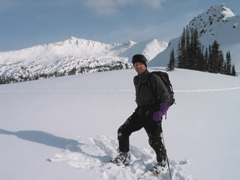
Dr. Andrew Slater is a research scientist at the National Snow and Ice Data Center. (Courtesy Andrew Slater, National Snow and Ice Data Center)
GELLERMAN: So you have the permafrost thawing. So what?
SLATER: That creates a lot of problems for infrastructure up in the north.
You’ve got roads that will become rather degraded, you’ve got buildings that can possibly collapse. States like Alaska are quite concerned about this because that can add a ten to twenty percent increase in the cost of maintaining infrastructure. And then the other real surprise package that we haven’t seen emerge yet but is definitely a potential is possibly the release of further greenhouse gases such as carbon dioxide and methane from the carbon stored in the soils.
GELLERMAN: Where does the carbon stored in the soil come from?
SLATER: Well, up in the North where it’s nice and cold, each year you get some vegetation growing. And then it dies and then because it’s so cold that vegetation does not decompose fully. Now when it does start to get warm that vegetation that has been stored in the soil can start to decompose and when it decomposes it can release possibly CO2 or methane.
GELLERMAN: So how much methane or carbon dioxide is there in Arctic soil that’s defrosting?
SLATER: That is an uncertain number at the moment but current estimates would say that there is about 950 gigatons. Now I’m not sure what that number means to a lot of people, but if you took the 950 gigatons and converted it to carbon dioxide in the atmosphere, you would more than double the current concentration of carbon dioxide in the atmosphere. That of course is a somewhat worst case scenario.
GELLERMAN: Ooh and that’s carbon dioxide and you also said there was methane, which is much more powerful as a greenhouse gas.
SLATER: Yes, well, the carbon that is stored in the soil it depends on how it decomposes. Generally if it decomposes in a drier fashion it can come out as carbon dioxide or if it decomposes under a wet situation and you get anaerobic decomposition, you can get methane coming out. And methane as you said is a far more powerful greenhouse gas but it is shorter lived in the atmosphere.
GELLERMAN: So the sea ice is melting because of global warming that’s causing the thawing of the soil, the permafrost, that’s releasing carbon dioxide and perhaps methane and that’s getting thing warmer.

Melting sea ice reduces the albedo, or reflective property, of the far north and causes arctic regions to heat more quickly than lower latitudes. Scientists are concerned that it could also hasten the melting of permafrost. (Courtesy of the National Snow and Ice Data Center)
GELLERMAN: And accelerate.
SLATER: Yes, that’s exactly right, yes.
GELLERMAN: So if I was to go, say, to the Arctic Circle and stand about 500 miles from the seashore and had a thermometer, would it be warmer there than it was say 20 years ago?
SLATER: Yes, there is definitely a warming signal in the Arctic. And the Arctic has warmed more than any other region on Earth.
GELLERMAN: And what’s the temperature there? How much has it increased over the last twenty years?
SLATER: The rate of warming in the Arctic is at least double that of what has been seen across the rest of the world in terms of a global mean.
GELLERMAN: So Doctor Slater, what effect does this melting have, on the land, have to terrestrial species, what happens?
SLATER: Areas that were formerly just tundra in the last 50 years have seen an encroachment of shrubs and shrubs that’s a sign well the soil there is thawing and it’s more amenable to shrub growth and woody growth. And maybe following the shrubs you might get movement of the tree line. An important point to throw in there is that well, we are seeing shrubs encroaching and shrubs and trees of course are a carbon sink so what you could have is the carbon that’s in the atmosphere being taken up and stored in this new vegetation so formerly you had very small vegetation on the tundra. And now you’ve got large vegetation in the form of tree and shrubs. And that can be a negative feedback. So you can suck up some of that carbon dioxide that has been put in the atmosphere.
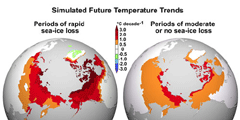
Simulations by global climate models show that when sea ice is in rapid decline, the rate of predicted Arctic warming over land can more than triple. (Courtesy of Steve Deyo, ©UCAR.)
SLATER: That is indeed a potential, it’s not just a doom and gloom runaway situation, there’s a lot of other things that can happen.
GELLERMAN: Doctor Slater, thanks you very much. Pleasure talking to you.
SLATER: Okay, thanks very much Bruce.
GELLERMAN: Andrew Slater is a research scientist at the National Snow and Ice Data Center, and co-author of a new study on permafrost appearing the latest edition of “Geophysical Research Letters.”
Agent Orange Researcher Passes
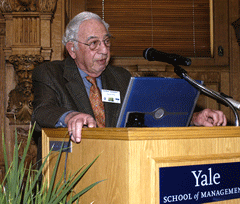
Arthur Galston. (Courtesy of Yale University)
Scientists have been at the forefront in drawing world attention to global warming despite attacks from naysayers who believe climate change is just a bunch of bunk. Of course scientists must determine for themselves their role in society and their responsibility for their discoveries. And this week we remember one scientist who labored mightily to undo his work. Biologist Arthur Galston conducted early research that led to the development of Agent Orange, the powerful herbicide the US used to lay waste to much of Vietnam. When Professor Galston realized how the defoliant was being used he led the effort to stop it - President Richard Nixon banned Agent Orange five years before the war ended. In 2003 Arthur Galston told Living on Earth that students need to be taught the risks of conducting scientific research:

Arthur Galston. (Courtesy of Yale University)
GELLERMAN: Plant biologist and bioethicist Arthur Galston died June 15th. He was 88.
[MUSIC: Todd Sickafoose “Tiny Resistors” from ‘Tiny Resistors’ (Cryptogramophone Record—2008)]
GELLERMAN: Coming up: Nano –Silver – away!!!! Small things considered on Living on Earth.
Small Technology, Big Questions
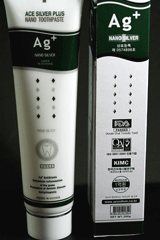
It might give you a gleaming nanosilver smile but what happens once it goes down the drain? (Photo: Alex Parlini, Courtesy of the Project on Emerging Nanotechnologies)
GELLERMAN: It’s Living on Earth, I’m Bruce Gellerman.
The nano technology industry says that very good things will come in very small packages, promising breakthrough medical cures, new materials and revolutionary products. But those tiny packages could also contain some nasty surprises. Nanotechnology deals in the smallest of the small, down at the size of atoms and molecules. But at that scale, things get really strange – carbon nanotubes are stronger than steel and nanogold turns intense red. Living on Earth is thinking big about small things with a new series of stories on nanotechnology we call “Let’s Get Small.”
Today, Living on Earth’s Jeff Young does a little shopping and finds - nanosilver.
[ENTERING GROCERY STORE]
YOUNG: I’m shopping in a Korean grocery store in Germantown, Maryland, with scientist Andrew Maynard. Maynard has just one item on his shopping list.
MAYNARD: This is a toothpaste that is imported from Korea that uses nanosilver particles so we’ll see if we can find it on the shelves here.
[GROCERY STORE NOISES ]
YOUNG: Maynard studies nanotechnology for the Woodrow Wilson International Center for Scholars in Washington. After a little poking around he finds toothpaste that claims that nanosilver will get your teeth cleaner.
MAYNARD: I don’t know about this particular toothpaste but certainly silver as antimicrobial works very well. It’s a very potent antimicrobial agent. Of course the question is if you have something so effective you have to work out how to use it sensibly how to use it wisely and that’s what seems to be lacking at the moment.
YOUNG: Were you surprised to see products like this start to show up?
MAYNARD: Yes I’ve been particularly surprised with products like this where you’re putting nano silver into something where it can definitely get into the body. Either with toothpaste in this form or in kids’ toys, kids pacifiers even. It’s almost as if manufacturers are like kids in a toy store at the moment. They’ve got new technology nanosilver and they’re just putting it everywhere they are so excited about it, but nobody’s really thinking about the long term consequences of that.
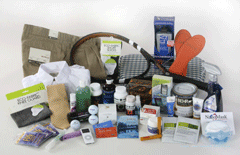
Some products made using nanotechnology. (Photo: David Hawxhurst)
MAYNARD: This is perhaps my favorite we have Benny the bear, who is a soft plush toy that has an inside foam impregnated with nanometer size silver particles.
YOUNG: And here’s some socks, same idea?
MAYNARD: Ultra fresh business socks, which contain again silver particles, the idea is that they kill bugs that lead to smelly feet. So you can wear these longer without developing antisocial habits. (Laughs)
YOUNG: Eventually, however, you’re going to want to wash those socks.
[WASHING MACHINE NOISE]
YOUNG: Researchers at Arizona State University found that after about four or five washings most brands start to leak their nanosilver particles, which go out with the water.
[BRUSHING TEETH NOISE]
YOUNG: And of course nanosilver toothpaste is largely going down the drain.
[DRAIN NOISE]
YOUNG: Then what?
ANDERSON: For most communities in the country, the wastewater treatment plant is the first entity to receive these materials.
YOUNG: That’s Cal Baier Anderson a health scientist tracking nanotechnology for the Environmental Defense Fund. She’s been hearing from people who manage sewage plants, who want to know what nanosilver might do to wastewater treatment.
ANDERSON: Bacteria - beneficial bacteria - are very important to this process they degrade or breakdown organic constituents that are present in the wastewater. If you’re introducing something like nano silver which is antibacterial and you wind up killing the good bacteria that will essentially put a halt to the treatment process.
YOUNG: Silver in its regular form can show up in wastewater from photo developing and metal working shops. Federal regulations limit how much can be emitted into rivers, lakes and bays—and for good reason. Silver, while largely benign for humans, is highly toxic to many freshwater fish. George Kimbrel at the non-profit International Center for Technology Assessment filed a petition with the Environmental Protection Agency, asking that nanosilver products be treated as pesticides.
KIMBREL: Nanosilver is quite a bit more toxic, 45 times more, by one study that bulk silver. Almost like a silver on steroids. We don’t know what that will do to the bottom of the food chain, to ecosystems in general.
YOUNG: And there’s another concern that nanosilver in the environment could create a threat to human health. Andrew Maynard of the Woodrow Wilson Center says widespread use could lead to resistant strains of bacteria.
MAYNARD: At the moment silver is one of our last defenses against some of these bugs these microbes that are resistant to many other forms of antimicrobial agents. If we give the secret of our last best defense away, silver, it leaves us with very little else to kill these harmful agents.
YOUNG: It is literally the silver bullet.
MAYNARD: It literally is the silver bullet and I think we have to use it judiciously.
YOUNG: Maynard says all this points to a glaring need for more study into potential environment and health risks. And some on Capitol Hill agree. Congress is working this summer to reauthorize funding for the National Nanotechnology Initiative. The initiative, managed by the White House office of science and technology coordinates about 1.3 billion dollars of nanotech research among a dozen federal agencies. However, only about three percent of that money went to health and environment research. Tennessee Democrat Bart Gordon, who chairs the House science committee, thinks that should be much higher.
GORDON: I don’t think they’ve done enough, although to their credit they have doubled funding in the last couple years, but more needs to be done. We’re gonna hold their feet to the fire.
YOUNG: Gordon says he wants society to realize the benefits of nanotechnology. He’s worried that development of good products could be stifled if the first products to market strike the public as unsafe. He points to the example of genetically modified crops.

It might give you a gleaming nanosilver smile but what happens once it goes down the drain? (Photo: Alex Parlini, Courtesy of the Project on Emerging Nanotechnologies)
YOUNG: There are indications that nanosilver may be starting to lose its shine for some businesses. Consider the case of Benny the bear—you remember the nano-stuffed animal we
met earlier. Benny’s been getting some good publicity lately…
[BENNY BEAR PROMO VIDEO]
TV HOST: This looks like a regular stuffed animal
GUEST: You know it does. But it actually is a very special little guy he’s the first antimicrobial bear so he’s safe for kids with allergies—what that translates to.
HOST: Let’s give one away here we go, Hey!
[CHEERS]
GUEST: Benny the bear!
YOUNG: But Benny’s makers do not like the kind of publicity nanosilver’s been getting. Roy Sharda is a partner in Pure Plushy, the Chicago business that created Benny.
SHARDA: We have used nano silver in the past there’s a lot of speculation as to how much nano silver technology is accepted. Anytime you see controversy you try to sort of avoid it.
YOUNG: Sharda has stopped using nanosilver in Benny the Bear. He says there are just too many questions about the material and how government might regulate it. But Sharda still believes in nanotechnology and thinks that in the long run the nanosilver dispute will be good if it brings more research.
SHARDA: I think it’s better to have this phase of controversy and have the truth come out than the other way around.
YOUNG: Call it the silver lining in the nanosilver products. Yes, commercialization may be getting ahead of needed research. But putting these products in the public’s hands could start an overdue national conversation on nanotechnology, with more people asking the big questions about these tiny materials.
For Living on Earth, I’m Jeff Young in Washington.
GELLERMAN: In the coming weeks, you'll hear more about the small stuff with big potential in our series "Let's Get Small." But If you can’t wait: for more information on nanotechnology, go to our website loe dot org.
Related links:
- Woodrow Wilson Center’s Project on Emerging Nanotechnology
- The federal government’s National Nanotechnology Initiative
- Government Accountability Office examination of the National Nanotechnology Initiative’s health and environment research
- Nanobusiness Alliance report on industry efforts to address environment and health safety
- Environmental Defense Fund’s nanotechnology project
- International Center for Technology Assessment’s petition to EPA
[MUSIC: Jacqui Naylor “Summertime” from ‘The Color Five’ (Ruby Star Records—2006)]
Green on the Go
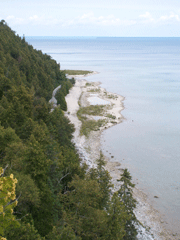
Mackinac Island in Michigan. (Photo: Amy Posten/amy.posten@gmail.com)
GELLERMAN: It’s summer time, but, this year, the livin’ ain’t so easy - not with the soaring price of energy putting a damper on vacation trips. But if you want to save some green, and be green, on your upcoming summer holiday, Tobin Hack may be able to help. She’s assistant editor at Plenty Magazine, and she joins me from New York City where the Green Zine is based. Plenty just came out with its travel issue. But, with gas prices so high, Tobin, I’m thinking a lot of folks must be downsizing their travel plans.
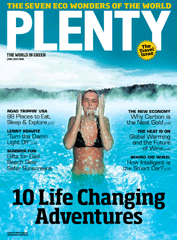
GELLERMAN: When I was, you know, growing up you could use the old thumb mobile but you can’t do that anymore.
[HACK LAUGHS]
HACK: Well, I can’t recommend hitchhiking but I can recommend ride-sharing services like GoLoco for example. You go online and look for other people who might be for example driving from New York to Boston and you might be traveling with strangers but you can check ‘em out ahead of time, make sure they’re okay.
GELLERMAN: So how do I pick a place?
HACK: Well we have a road trip feature in our current magazine, sort of guiding people around the country to various green destinations and just think about what you haven’t maybe explored or enjoyed in your area. If you live in California, think about taking an organic wine tasting trip up the coast, you know rent a Prius and do that. Or if you live in Michigan, go head out to Mackinac Island, which is a car-free island so you get there and you’ll be traveling around by foot or even by horse-and-buggy, a really low CO2 way to go.

Mackinac Island in Michigan. (Photo: Amy Posten/amy.posten@gmail.com)
HACK: That’s architect Michael Reynolds. He’s a really groundbreaking architect who works with, believe it or not, trash. He builds these structures called “Earthships” out of old tires, old beer bottles, old soda cans and this one, obviously, you can actually go stay in. They’re sort of dome-like, and they’re really cool looking, sort of futuristic, off the grid, very sustainable.
GELLERMAN: Hm, you can trash the place before you even get there.
[HACK LAUGHS]
GELLERMAN: I was looking at some travel pages and it seems cruise ships are an affordable way of going.
HACK: Cruise ships do have a large footprint. You know these really big cruise ships can hold as many as 5,000 people and they’re dumping sewage into the ocean. They’re not a great way to go. So what we like to recommend instead is go with a smaller cruise ship expedition like Lindblad or Cruise North Expeditions. Lindblad actually partners with the World Wildlife Foundation and National Geographic to promote conservation so they’re working for conservation in that way and also a smaller group is always a more eco way to go. Another great option is just to go by sailboat. Explore Greece by catamaran for example, explore Maine by sailboat. You’ll really get to know the place better and it’s so much more relaxing.
GELLERMAN: I know a lot of people like to volunteer on their vacations. You know they work a whole year and take two weeks off and volunteer.
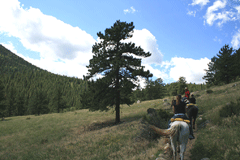
Horseback riding in the Rockies. (Photo: Amy Cesich)
GELLERMAN: So Tobin, where are you planning to go this summer?
HACK: Uh, I’m going to be working.
[GELLERMAN LAUGHS]
HACK: But let’s see, can I pick my dream destination?
GELLERMAN: Sure.
[HACK LAUGHS]
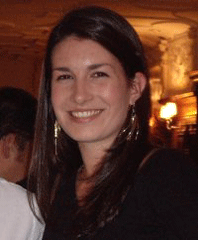
Tobin Hack is an Assistant Editor for Plenty magazine.
GELLERMAN: Well Tobin if you go, you know, West that’s a long trip, how do you make that a green trip?
HACK: Well one thing you can do in terms of air travel of course is offset your flight. It’s a controversial step that people take but it’s better than nothing. An average length flight will only cost you about twenty dollars to offset.
GELLERMAN: Controversial how, Tobin?
HACK: I think a lot of critics feel that the money you pay doesn’t make up for the CO2 that’s emitted. But you know all of these offsetting and ecosteps are evolving and the important thing is to be making the effort, to be exploring the options.
GELLERMAN: Tobin Hack is an assistant editor at Plenty Magazine. To find out more about greening your vacation, check out our website, L-O-E dot org. Tobin, it was a pleasure.
HACK: Thanks so much Bruce.
Related links:
- Plenty Magazine
- Eco-inquiries, conundrums, snafus? Write to Tobin Hack
Bumper to Bumper Bikes
GELLERMAN: The spike in gas prices has an increasing number of people turning to spokes – spokes on bikes, that is. According to Merrill Lynch, bike sales are up five percent this year, while car sales are stalled – down at eleven percent. And even in bike-treacherous Los Angeles where the car is king and rules the road, sales of two-wheel people powered machines are brisk. LOE’s Ingrid Lobet sent us this audio postcard from a bike shop in LA.
[BIKE SHOP SOUNDS]
RANCIER: My name is Candace Rancier. I am the manager of Palms Cycle. My family has owned Palms Cycle since the 1960s. The store has been here since the 1930s. It's pretty much known as the oldest store in Los Angeles as …far as we know.
Since it's been getting hotter and the gas prices have been going up, we have a lot of repairs.
I basically can't keep anything in stock.
The biggest favorite lately is the grocery bag panniers, they attach to a rack on the back of your bike and they fit grocery bags in 'em perfectly.
The lights, the locks, helmets, stuff that people use pretty much every day to go to work.
We've been ordering a lot of bags and baskets too, because people have been using their bikes to go to work.
My repair department is booked almost two weeks out.
Doing probably about ten tune-ups a day, along with the walk-ins …and brand new bicycle builds that we have to put on the floor.
It's pretty much gotten to the point where bikes are, it's less expensive to buy a bike than it is to pay for gas for a month.
The big problem now for us as a business is because the gas prices are going up, so are the bicycles. Every week I get a new price list from my companies saying the price went up ten, to twenty percent. Because the tires and the grips and a lot of the materials that are on the bicycle are made of petroleum. All the bikes are made in China or Taiwan so they are shipped here, then they're shipped to the warehouse, then they have to be shipped to us.
If the gas prices keep going up this way …I think we are going to see a lot more bikes on the street, actually.
GELLERMAN: Living on Earth’s Ingrid Lobet rides her bike in Los Angeles – and produced our story. Living on Earth’s Ashley Ahearn rides her bike in Boston – and recently got an earful from some bicycling commuters during rush hour….
[CROSS WALK SOUNDS, TRAFFIC AMBIANCE]
AHEARN: Before the light changes here, what’s the best part about riding your bike to work?
WOMAN: Um, not being in a car.
MAN: Good exercise, you get some fresh air.
WOMAN: My commute on the T is usually an hour. Biking it’s a half hour.
MAN: It really wakes me up, it’s better than coffee I think.
WOMAN: You make commuting recreation instead of a chore.
[HORNS HONKING]
AHEARN: And what’s the pits about riding your bike in the morning to work?
MAN: Sweating.
WOMAN: Yeah when I get to work I have to sink shower, which is kind of nasty.
WOMAN: The traffic, the potholes, the bike lanes, people opening their car doors, cutting in.
AHEARN: How ‘bout traffic, have you had an close calls?
WOMAN: In 26 years, I’ve had very few problems or times when I felt scared.
WOMAN: I’ve actually been hit. This woman ran right into me, totaled my bike, nearly crushed my foot but luckily I was able to get away from that.
MAN: Oh, I’ve been hit several times but it wasn’t any major thing and usually the cars just drive away.
[HONKING]
AHEARN: Do you get bike rage?
WOMAN: Yes.
[LAUGHTER]
MAN: Yeah, I get bike rage and it’s unfortunate so I try to stick out my tongue, instead of give the finger but it’s hard to resist.
WOMAN: Drivers are bad, but so are bikers and so are pedestrians. We’re all out for ourselves rather than like following the rules. [Laughs]
AHEARN: They do say Boston drivers are the worst. Are Boston bikers the worst?
WOMAN: Um, I think we all are about equal.
[LAUGHTER]
AHEARN: Thank you so much.
WOMAN: No problem.
AHEARN: Have a good commute.
WOMAN: You too.
[HORNS HONKING, CROSSWALK COUNTDOWN NOISE]
GELLERMAN: Gripes, groans and grinding gears on the mean streets of Boston collected by Living on Earth’s Ashley Ahearn.
[MUSIC: Melanie “Brand New Key” from ‘Gather Me’ (Two Story Records—1971)]
GELLERMAN: Coming up: Biodiversity – what’s in it for you - Stay tuned to Living on Earth!
[MUSIC: Ivan “Boogaloo” Jones : Sweetback from Bag Of Goodies (Ubiquity/Luv N’ Haight Records 2001)]
Warm Water and Small Sea Creatures
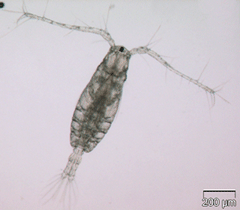
A typical zooplankton species found in the North Sea. (Courtesy of the Alfred Wegener Institute)
GELLERMAN: It’s Living on Earth. I’m Bruce Gellerman.
Plankton get no respect. The tiny marine animals aren’t charismatic like polar bears, cuddly like pandas or awe-inspiring, like whales. But without plankton, the whole ocean food web would unravel, which is starting to happen in some places. One of them: Helgoland in the North Sea, where Radio Deutsche Welle’s Andrew Ryan traveled for our story.
[WATER NOISES; MOTOR ROARING]
RYAN: Our small white research vessel pitches across the channel that divides the two islands of Helgoland. Storm clouds are gathering overhead but with our fluorescent orange rain gear we’ll stay dry as a bone. This is a typical research run, and our mission is to check the water temperature and salinity and pull in samples of both water and marine life.
WILTSHIRE: What you see now is a big net which has just been put in and we will tow it, it’s called a cuckofie where we’ll actually sieve out all the small organisms. And when it comes back on board, you’ll see that it’s sort of like a big soup.
RYAN: That’s Professor Karen Wiltshire, one of the director’s of the Alfred Wegener Institute’s Helgolan Marine Research Station. She’s my guide for today’s sea excursion.
RYAN: What’s gonna be in our soup today?
WILTSHIRE: Well my guess is that there will be very, very many microalgae, little tiny algae, and you won’t actually see them with the naked eye except that you’ll see this sort of sludge and if you look at it under a microscope there are millions and millions of little cells.
RYAN: It doesn’t sound like the most delicious soup, but for marine creatures this is a veritable buffet. But as we’ll find out the menu is changing, and with those changes come new customers.
Workers hoist in a long, white gauze net which looks a bit like a windsock. Then they pour the contents into a bucket.
[SPLASHING NOISES]
WILTSHIRE: There’s not very much in it at the moment actually.
RYAN: So it’s kind of a brown, sludgy color.
WILTSHIRE: Yeah, actually the brown in it is most likely microalgae because they have pigments because they photosynthesize.
RYAN: Is this the phytoplankton?
WILTSHIRE: Yeah, exactly, it’s the phytoplankton. Those are the ones that we’re looking at very closely here because they’re at the bottom of the food chain, it’s what basically everyone feeds on. So if something changes at the bottom, you can expect an upward cascading effect. So that’s why we look at it everyday.
RYAN: Marine biologists have been monitoring changes in the waters around Helgoland everyday since 1962. And the biggest change they’ve noticed has been the temperature, which has gone up 1.5 degrees Celsius in the last fifty years. And even more dramatically, the winter temperatures alone have increased by four degrees. As a result, fish like Cod, which like cold water, have moved north. And near Helgoland, researchers have seen an influx of warm water fish like Red Mullets and a diverse array of jellies and little crustaceans. Karen Wiltshire says that warmer water has also had a profound effect on the ocean’s microalgae, the phytoplankton.
WILTSHIRE: Well what we see is that the timing of the spring bloom is very much affected by how warm it is in winter. It’s just like on land, you end up having the plants starting to grow in early spring and here it’s the same in the sea. You’ve got microalgae, which will start to grow and then things feed on it and then everything starts to get going. And if that timing is changed you have shifts in the whole food chain structure.
RYAN: She says that if it’s warm in winter then the algae are prematurely eaten away. That means they don’t have time to build up biomass. And then other organisms who rely on them for food suffer. Some researchers say that those changes even have an effect on the largest animals in our world’s oceans: the whales.
[FLAPPING WATER NOISES]
RYAN: Back on the boat, workers have brought the net in once again.
And it looks like they’ve pulled in a new catch here and this one seems to be full of…
WILTSHIRE: Lots of jellyfish, big jellyfish. It’s ten, twenty five degrees which is warm.
RYAN: The water is warm.
WILTSHIRE: Yeah it is warm, and these are HUGE jellyfish for this time of the year. I mean, they’ve been feeding well. So the water’s been warm all winter.

A typical zooplankton species found in the North Sea. (Courtesy of the Alfred Wegener Institute)
WILTSHIRE: Oh yeah, that must have been there all winter.
RYAN: And it’s transparent.
WILTSHIRE: Yeah.
RYAN: And probably about, what, four centimeters long?
WILTSHIRE: In this case, yeah. There’s a smaller one here, I’m used to these small ones. Look there, see? That’s more what I’m used to in size.
RYAN: A little smaller than a grape.
WILTSHIRE: Exactly, yeah.
RYAN: Maybe about the size of an almond.
WILTSHIRE: Exactly. That means this guy has been here for a while. So he had a good winter.
RYAN: He’s been having some good dinners on phytoplankton there.
WILTSHIRE: Yeah, exactly. They can eat a whole bookish of phytoplankton, or zooplankton mostly.
RYAN: The question is then, with new, larger feeders munching on it all winter, is the phytoplankton endangered?
WILTSHIRE: Ah, I would say its certain species are endangered, not the whole group of phytoplankton. It’s biodiversity that you have to worry about. And changes in species composition of phytoplankton populations. It’s not actually the fact that they’re all going to die out.
RYAN: But Karen Wiltshire says that the real danger is, and they know this from land-based food chains, if you remove one link from the chain it could cause the whole system to collapse.
[WALKING NOISES]
RYAN: Now it’s time to go back to the Alfred Wegener Institute with our buckets of water and seafood…I mean, marine life.
WILTSHIRE: Okay, this is the lab where we count all our samples.
RYAN: Marine biologists are busy preparing the water sample that we caught earlier. They fix it with a few drops of iodine, which kills the organisms, and then pour a tiny amount onto a glass tray. That’s what goes under the microscope and gets counted.
WILTSHIRE: Maybe you would like to just have a look in.
RYAN: Okay, so I’m going to have a look into the microscope. Are those plankton?
WILTSHIRE: That’s plankton, phytoplankton!
RYAN: I’ve seen it! I’ve seen it, I’ve seen phytoplankton.
WILTSHIRE: Yeah, exactly.
[WATER LAPPING]
RYAN: For a moment, just one, short, magical moment, I marveled at how the weight of our oceans rests on the wellbeing and proliferation of this tiny organism known as plankton.
Andrew Ryan, Helgoland.
GELLERMAN: Our story about plankton comes to us courtesy of Radio Deutsche Welle.
Related links:
- Alfred Wegener Institute - Helgoland
- PlanktonNet – EU-funded website with data on plankton
- Radio Deutsche Welle’s “Living Planet”
Sustaining Life
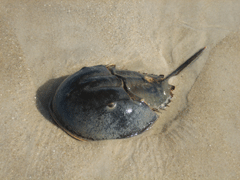
The horseshoe crab is essential to keeping vaccinations safe. (Photo: Andrew Farrington)
Variety isn’t just the spice of life…it’s essential for life. According to the new book “Sustaining Life, How Human Health Depends upon Biodiversity,” we need birds, bugs, and bacteria a lot more than they need us. We use them for medicines, biomedical and agricultural research, and new materials. But we’re wiping out vast numbers of species and ultimately, we’ll pay the price. Joining me in the studio are the co-editors of “Sustaining Life,” Doctors Eric Chivian and Aaron Bernstein. Dr. Chivian is Founder and Director of Harvard Medical School’s Center for Health and the Global Environment. Dr. Bernstein is a research associate at the Center and a clinical fellow in pediatrics at Children's Hospital Boston and Boston Medical Center. Welcome to you both.
CHIVIAN: Thank you very much.
BERNSTEIN: Thanks Bruce.
GELLERMAN: Let me start with you, Dr. Chivian. Why a book on sustaining life, why a book on biodiversity?
CHIVIAN: More than a hundred scientists worked with Ari and myself in putting this book together. We did this because it’s been our sense that the loss of biodiversity and other issues like climate change are too abstract for people to grasp, it’s too far from their everyday life. And it was our conviction that if people really understood their connection to nature by looking at the impacts on their health from losing species then they would really do everything in their power to protect it.
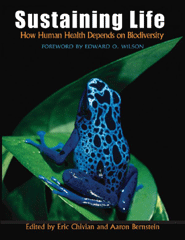
BERNSTEIN: That’s right. If you look back at the history of our earth there have been five great extinction events and the present extinction event has been called the sixth because the rate of species loss is on par with the past five, the most recent of which was 65 million years ago.
That extinction event occurred as the result of an asteroid landing in the Gulf of Mexico and causing a huge cloud to essentially block off all sunlight on the Earth. That wiped out the dinosaurs as well as about half of all the species alive on earth at that time. The rate of species extinction then is about the same as the rate of species extinction today.
GELLERMAN: But the difference is that we’re responsible for it and not an asteroid.
BERNSTEIN: That’s correct.
CHIVIAN: So I think that it’s important for us to recognize that we are not endangering life on Earth, we are endangering ourselves. This conceit that we are so powerful that we are going to wipe out life on Earth is just a falsehood. It’s going to continue, evolve over several more millions of year and do just fine. But we may not be around to see it.
GELLERMAN: One of the animals that has defied, kind of, evolutionary history is the horseshoe crab. I mean it’s been around forever and ever and it hasn’t changed much. And I didn’t realize the important place it holds in the pharmacopedia of the world?
BERNSTEIN: Yeah anyone listening to this who feels old all you have to do is read about the horseshoe crab and you’ll feel like a kid again.
GELLERMAN: 50 million years.
BERNSTEIN: Yeah and then some. Horseshoe crabs are the great survivors of evolution and the FDA’s gold standard test to detect the presence of bacterial contamination or vaccine supply. When I give a child a vaccine, which is probably the most important thing I do as a doctor to prevent disease, how do I know that that vaccine is safe?
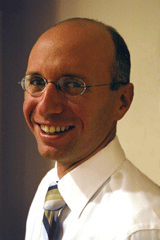
Dr. Aaron Bernstein.
GELLERMAN: How many species are there on the planet? Do we know?
CHIVIAN: Well scientists have identified somewhere between 1.5 and 1.75 million species that they’ve given Latin names to. And there are estimates anywhere from ten times that to even a hundred times that. But it’s clear that we only know a small fraction of the species on Earth. We know very little for example about species in the deep oceans. We know almost nothing about microbial species. There have been for example 700 distinct bacterial species identified in the human mouth alone. There’s a termite whose guts have been opened up and they identified more than 400 different bacterial microbial species in the gut of that termite. Does another termite have another 400? We know almost nothing about life on this planet.
GELLERMAN: One of the fascinating parts about your book is how you connect the dots, how you make diversity matter to me. And it’s the microbes that take center stage.
BERNSTEIN: I think it’s easier for people to grasp what we like to call the charismatic mega-fauna. These are the critters that are kept in zoos and they can really visualize them and have a sense that they exist. The reality though is that the microbial world is not only where the majority of genetic diversity exists. But it’s also where our health depends in immeasurable proportions on. The antibiotics I prescribe everyday in my practice that I give to children to treat common childhood diseases through most life-threatening diseases we see come from microbes. Without those microbes we wouldn’t have those medicines.
GELLERMAN: You write about the South American Leap Frog and you say it has the potential of antibiotic library of enormous potential. The Leap Frog?
BERNSTEIN: The Leap Frog. One of the extraordinary attributes of many amphibians are antimicrobial peptides that they secrete on to their skins. And while we don’t fully understand why they do this we do know that the compounds may be extraordinarily important for the treatment of bacterial infections. Most antibiotics we use when we use them too much the bacteria develop resistance so if we keep using the antibiotic it no longer is able to treat the infection. And what the frog skin peptides have been shown to be capable of are essentially assaulting bacteria in ways that make them incapable of becoming resistant to them.
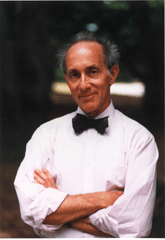
Dr. Eric Chivian
BERNSTEIN: They are among the most threatened groups of organisms on Earth. About a third of all amphibian species are threatened with extinction.
GELLERMAN: I wanted to ask you about this frog that swallows its own eggs and then delivers a live birth. And you say that something in that frog’s stomach, which will maybe help us cure ulcers?
CHIVIAN: The Gastric Brooding Frog, there are two known species. They were both found in Australia. The female swallows the fertilized eggs. The eggs hatch in her stomach. They become tadpoles and when they reach a certain level of development the mother vomits them out into an aquatic environment where they complete their development and become adults. Now all amphibians, all vertebrates, us as well, begin the process of digestion in our stomachs. We release acid and enzymes that starts digesting our food. So these tadpoles were found to secrete substances to stop the acid, to stop the enzymes, and to prevent them being emptied into the intestines. So scientists began to study these compounds because yes we have some ways of treating peptic ulcer disease, which affects 25 million Americans. But these compounds may have worked by a completely different mechanism, may have been much more effective than what we now do to treat ulcers but these studies had to stop because both species of Gastric Brooding Frogs went extinct. We will never know what those compounds were.
GELLERMAN: It seems like we’re sawing off entire limbs of our family tree, of the tree of life.

The horseshoe crab is essential to keeping vaccinations safe. (Photo: Andrew Farrington)
GELLERMAN: If there was one species that you could save right now that’s endangered that really has consequence today in our lives, what would it be?
CHIVIAN: I don’t think I can answer that. I think if we were talking about groups of species I could answer that and I would give you several candidates because all life on earth is dependent on it. Plants, we have no oxygen without plants. Microbes, of all types, the microbes that break down decaying organisms and return the nutrients to the soil and to the oceans. Nitrogen-fixing bacteria. We would have very few crops without nitrogen-fixing bacteria putting nitrogen that’s unusable from the atmosphere into the soil.
You know I’m somewhat biased as a member of the homosapiens, that I think I would like to save us, because we’re such a powerful force unfortunately for destruction but we’re also a potentially powerful force for good. And that’s why we dedicate this book to not only the plants and animals and microbes that we share this planet with, but we dedicate this book to homosapiens, our own species. And we say to them, “May we have the wisdom and the love for our children and for all children to come, to save the indescribably beautiful and precious gift we have been given.”
GELLERMAN: Well, Dr. Chivian, thank you so very much, really appreciate it.
CHIVIAN: My pleasure.
GELLERMAN: And Dr. Bernstein, thank you very much.
BERNSTEIN: A great pleasure Bruce, thank you.
GELLERMAN: Dr. Eric Chivian shared the noble peace prize in 1985, Dr. Aaron Bernstein is a pediatrician in Boston. They’re co-editors of the new book from Oxford University Press, “Sustaining Life: How Human Health Depends upon Biodiversity”.
Related link:
For more on the book “Sustaining Life,” click here
[MUSIC: George Kahn “Comfortably Numb” from ‘Cover Up’ (Playing Records—2008)]
GELLERMAN: Living on Earth is produced by the World Media Foundation. Our crew includes Ashley Ahearn, Bobby Bascomb, Eileen Bolinsky, Ingrid Lobet, Helen Palmer, Mitra Taj and Jeff Young, with help from Sarah Calkins and Marilyn Govoni.
Our interns are Luke Borders, Kim Gittleson and Jessica Ilyse Smith. Jeff Turton is our technical director. Alison Lirish Dean composed our themes. You can find us at LOE dot org. Steve Curwood is our executive producer. I’m Bruce Gellerman. Thanks for listening.
ANNOUNCER: Funding for Living on Earth comes from the National Science Foundation, supporting coverage of emerging science, and Stonyfield Farm: organic yogurt and smoothies. Stonyfield pays its farmers not to use artificial growth hormones on their cows. Details at stonyfield.com. Support also comes from you our listeners, the Ford Foundation, the Town Creek Foundation, the Oak Foundation supporting coverage of climate change and marine issues and Pax World Mutual Funds: socially and environmentally sustainable investing. Pax World: for tomorrow. On the web at paxworld.com.
ANNOUNCER 2: PRI: Public Radio International.
Living on Earth wants to hear from you!
Living on Earth
62 Calef Highway, Suite 212
Lee, NH 03861
Telephone: 617-287-4121
E-mail: comments@loe.org
Newsletter [Click here]
Donate to Living on Earth!
Living on Earth is an independent media program and relies entirely on contributions from listeners and institutions supporting public service. Please donate now to preserve an independent environmental voice.
NewsletterLiving on Earth offers a weekly delivery of the show's rundown to your mailbox. Sign up for our newsletter today!
 Sailors For The Sea: Be the change you want to sea.
Sailors For The Sea: Be the change you want to sea.
 The Grantham Foundation for the Protection of the Environment: Committed to protecting and improving the health of the global environment.
The Grantham Foundation for the Protection of the Environment: Committed to protecting and improving the health of the global environment.
 Contribute to Living on Earth and receive, as our gift to you, an archival print of one of Mark Seth Lender's extraordinary wildlife photographs. Follow the link to see Mark's current collection of photographs.
Contribute to Living on Earth and receive, as our gift to you, an archival print of one of Mark Seth Lender's extraordinary wildlife photographs. Follow the link to see Mark's current collection of photographs.
 Buy a signed copy of Mark Seth Lender's book Smeagull the Seagull & support Living on Earth
Buy a signed copy of Mark Seth Lender's book Smeagull the Seagull & support Living on Earth

